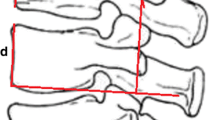Abstract
Objectives
The treatment of acute thoracolumbar fractures is a demanding and fine surgical challenge. Conventional procedures are not always satisfactory enough because of postoperative complications of failure of posterior instrumentation or lumbodorsal pain etc. This prospective outcome study was undertaken to investigate the improvement of the surgical treatment effect on acute thoracolumbar fractures by performing modified surgeries.
Methods
Nineteen patients with acute thoracolumbar fractures and associated incomplete neurologic deficit, subjected to the methods of transpedicular intracorporeal hydroxyapatite grafting and pedicle screw fixation through paraspinal approach, were reviewed after a minimum follow-up of 2 years. Nineteen patients all suffered from a single thoracolumbar fracture. The mean preoperative ratio of the height of the anterior border was 57.2%, kyphosis degree was 21.6°, and occupancy of canales spinalis was 30.5%. The radiographic parameters were evaluated, and clinical records were reviewed.
Results
The average operating time was 112.4 min, and the mean blood loss was 123.7 ml. The neurologic function of all 19 patients was improved by at least one American Spine Injury Association grade, with 17 (89.5%) having complete neurologic recovery. The mean height of injured spine was corrected from 57.2% to 88.4% at the most recent follow-up, and the kyphosis was corrected from 21.6° to 4.8°. There was only one patient (5.3%) who complained that the operative area was a little painful, and the remaining patients did not claim pain in waist and back.
Conclusions
Transpedicular intracorporeal hydroxyapatite grafting and pedicle screw fixation through paraspinal approach could provide reliable neurologic improvement in patients with incomplete neurologic deficit, and could prevent the development of kyphosis. Furthermore, it has the obvious advantages of less invasion and blood loss, and decreases the risks of postoperative lumbodorsal pain.









Similar content being viewed by others
References
Korovessis P, Baikousis A, Zacharatos S, Petsinis G, Koureas G, Iliopoulos P (2006) Combined anterior plus posterior stabilization versus posterior short-segment instrumentation and fusion for mid-lumbar (L2–L4) burst fractures. Spine 31:859–868
McKiernan F, Faciszewski T, Jensen R (2003) Reporting height restoration in vertebral compression fractures. Spine 28:2517–2521
Bridwell KH, Dewald RL (1997) Spinal surgery, 2nd edn. Lippincott-Raven, Philadelphia, pp 1839–1880
Angevine PE, Dickman CA, Mccormick PC (2007) Lumbar fusion with and without pedicle screw fixation: comments on a prospective, randomized study. Spine 32:1466–1471
Leferink VJ, Zimmerman KW, Veldhuis EF, ten Vergert EM, ten Duis HJ (2001) Thoracolumbar spinal fractures: radiological results of transpedicular fixation combined with transpedicular cancellous bone graft and posterior fusion in 183 patients. Eur Spine J 10:517–523
Parker JW, Lane JR, Karaikovic EE, Gaines RW (2000) Successful short-segment instrumentation and fusion for thoracolumbar spine fractures: a consecutive 41/2-year series. Spine 25:1157–1170
Butt MF, Farooq M, Mir B, Dhar AS, Hussain A, Mumtaz M (2007) Management of unstable thoracolumbar spinal injuries by posterior short segment spinal fixation. Int Orthop 31:259–264
McLain RF, Sparling E, Benson DR (1993) Early failure of short-segment pedicle instrumentation for thoracolumbar fractures: a preliminary report. J Bone Joint Surg Am 75:162–167
Gejo R, Matsui H, Kawaguchi Y, Ishihara H, Tsuji H (1999) Serial changes in trunk muscle performance after posterior lumbar surgery. Spine 24:1023–1028
German JW, Foley KT (2005) Minimal access surgical techniques in the management of the painful lumbar motion segment. Spine 30(16 Suppl):S52–S59
Kawaguchi Y, Yabuki S, Styf J, Olmarker K, Rydevik B, Matsui H, Tsuji H (1996) Back muscle injury after posterior lumbar spine surgery. Topographic evaluation of intramuscular pressure and blood flow in the porcine back muscle during surgery. Spine 21:2683–2688
Park P, Garton HJ, Gala VC, Hoff JT, Mcgillicuddy JE (2004) Adjacent segment disease after lumbar or lumbosacral fusion: review of the literature. Spine 29:1938–1944
Aebi M, Thalgott JS, Webb JK (1998) AO ASIF principles in spine surgery. Springer, Berlin, pp 107–122
Watkins MB (1959) Posterolateral bone-grafting for fusion of the lumber and lumbosacral spine. J Bone Joint Surg Am 41:388–396
Ozgur BM, Yoo K, Rodriguez G, Taylor WR (2005) Minimally-invasive technique for transforaminal lumbar interbody fusion (TLIF). Eur Spine J 14:887–894
Wiltse LL, Guyer RD, Spencer CW, Glenn WV, Porter IS (1984) Alar transverse process impingement of the L5 spinal nerve: the far-out syndrome. Spine 9:31–41
Alanay A, Acaroglu E, Yazici M, Oznur A, Surat A (2001) Short-segment pedicle instrumentation of thoracolumbar burst fractures: does transpedicular intracorporeal graft prevent early failure? Spine 26:213–217
Toyone T, Tanaka T, Kato D, Kaneyama R, Otsuka M (2006) The treatment of acute thoracolumbar burst fractures with transpedicular intracorporeal hydroxyapatite grafting following indirect reduction and pedicle screw fixation: a prospective study. Spine 31:E208–E214
Wiltse LL, Bateman JG, Hutchinson RH, Nelson WE (1968) The paraspinal sacrospinalis-splitting approach to the lumbar spine. J Bone Joint Surg Am 50:919–926
Wiltse LL, Spencer CW (1988) New uses and refinements of the paraspinal approach to the lumbar spine. Spine 13:696–706
Olivier E, Beldame J, Slimane MO, Defives T, Duparc F (2006) Comparison between one midline cutaneous incision and two lateral incisions in the lumbar paraspinal approach by Wiltse: a cadaver study. Surg Radiol Anat 28:494–497
Wang XY, Dai LY, Xu HZ, Chi YL (2008) Kyphosis recurrence after posterior short-segment fixation in thoracolumbar burst fractures. J Neurosurg Spine 8:246–254
Acknowledgments
We acknowledge the written consent for publication obtained from the patient featured in the manuscript.
Competing interests
We declare that we have no competing interests.
Author information
Authors and Affiliations
Corresponding author
Rights and permissions
About this article
Cite this article
Lin, D., Guo, L., Ding, Z. et al. Modified surgery for acute thoracolumbar fractures: a prospective report. Eur Orthop Traumatol 2, 33–39 (2011). https://doi.org/10.1007/s12570-011-0051-0
Received:
Accepted:
Published:
Issue Date:
DOI: https://doi.org/10.1007/s12570-011-0051-0




